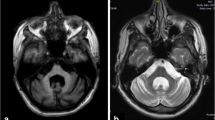Abstract
The management of sporadic late-onset cerebellar ataxias represents a very heterogeneous group of patients and remains a challenge for neurologist in clinical practice. We aimed at describing the different causes of sporadic late-onset cerebellar ataxias that were diagnosed following standardized, exhaustive investigations and the population characteristics according to the aetiologies as well as at evaluating the relevance of these investigations. All patients consecutively referred to our centre due to sporadic, progressive cerebellar ataxia occurring after 40 years of age were included in the prospective, observational study. 80 patients were included over a 2 year period. A diagnosis was established for 52 patients (65%) corresponding to 18 distinct causes, the most frequent being cerebellar variant of multiple system atrophy (n = 29). The second most frequent cause was inherited diseases (including spinocerebellar ataxias, late-onset Friedreich’s disease, SLC20A2 mutations, FXTAS, MELAS, and other mitochondrial diseases) (n = 9), followed by immune-mediated or other acquired causes. The group of patient without diagnosis showed a slower worsening of ataxia (p < 0.05) than patients with multiple system atrophy. Patients with later age at onset experienced faster progression of ataxia (p = 0.001) and more frequently parkinsonism (p < 0.05) than patients with earlier onset. Brain MRI, DaT scan, genetic analysis and to some extent muscle biopsy, thoracic-abdominal-pelvic tomodensitometry, and cerebrospinal fluid analysis were the most relevant investigations to explore sporadic late-onset cerebellar ataxia. Sporadic late-onset cerebellar ataxias should be exhaustively investigated to identify the underlying causes that are numerous, including inherited causes, but dominated by multiple system atrophy.


Similar content being viewed by others
References
Klockgether T (2010) Sporadic ataxia with adult onset: classification and diagnostic criteria. Lancet Neurol 9:94–104
Muzaimi MB, Thomas J, Palmer-Smith S et al (2004) Population based study of late onset cerebellar ataxia in south east Wales. J Neurol Neurosurg Psychiatry 75:1129–1134
van de Warrenburg BPC, van Gaalen J, Boesch S et al (2014) EFNS/ENS Consensus on the diagnosis and management of chronic ataxias in adulthood. Eur J Neurol 21:552–562
Gilman S, Wenning GK, Low PA et al (2008) Second consensus statement on the diagnosis of multiple system atrophy. Neurology 71:670–676
Anheim M, Tranchant C, Koenig M (2012) The autosomal recessive cerebellar ataxias. N Engl J Med 366:636–646
Schöls L, Szymanski S, Peters S et al (2000) Genetic background of apparently idiopathic sporadic cerebellar ataxia. Hum Genet. 107:132–137
Moseley ML, Benzow KA, Schut LJ et al (1998) Incidence of dominant spinocerebellar and Friedreich triplet repeats among 361 ataxia families. Neurology 51:1666–1671
Le Ber I, Camuzat A, Castelnovo G et al (2003) Prevalence of dentatorubral-pallidoluysian atrophy in a large series of white patients with cerebellar ataxia. Arch Neurol 60:1097–1099
Durr A (2010) Autosomal dominant cerebellar ataxias: polyglutamine expansions and beyond. Lancet Neurol 9:885–894
Lecocq C, Charles P, Azulay J-P et al (2016) Delayed-onset Friedreich’s ataxia revisited. Mov Disord Off J Mov Disord Soc 31:62–69
Jacquemont S, Hagerman RJ, Leehey M et al (2003) Fragile X premutation tremor/ataxia syndrome: molecular, clinical, and neuroimaging correlates. Am J Hum Genet 72:869–878
Apartis E, Blancher A, Meissner WG et al (2012) FXTAS: new insights and the need for revised diagnostic criteria. Neurology 79:1898–1907
Renaud M, Perriard J, Coudray S et al (2015) Relevance of corpus callosum splenium versus middle cerebellar peduncle hyperintensity for FXTAS diagnosis in clinical practice. J Neurol 262:435–442
Nicolas G, Richard A-C, Pottier C et al (2014) Overall mutational spectrum of SLC20A2, PDGFB and PDGFRB in idiopathic basal ganglia calcification. Neurogenetics 15:215–216
Hsu SC, Sears RL, Lemos RR et al (2013) Mutations in SLC20A2 are a major cause of familial idiopathic basal ganglia calcification. Neurogenetics 14:11–22
Szmulewicz DJ, Waterston JA, Halmagyi GM et al (2011) Sensory neuropathy as part of the cerebellar ataxia neuropathy vestibular areflexia syndrome. Neurology 76:1903–1910
Anheim M, Fleury M, Monga B et al (2010) Epidemiological, clinical, paraclinical and molecular study of a cohort of 102 patients affected with autosomal recessive progressive cerebellar ataxia from Alsace, Eastern France: implications for clinical management. Neurogenetics 11:1–12
Ashour R, Jankovic J (2006) Joint and skeletal deformities in Parkinson’s disease, multiple system atrophy, and progressive supranuclear palsy. Mov Disord Off J Mov Disord Soc 21:1856–1863
Author information
Authors and Affiliations
Corresponding author
Ethics declarations
Conflicts of interest
The authors have no conflict of interest to declare except MA and MM. MA declares honoraria and travel grants from Actelion Pharmaceuticals, UCB, Teva, and AbbVie. MM declares congress fee registration from LFB Biomedicaments.
Rights and permissions
About this article
Cite this article
Gebus, O., Montaut, S., Monga, B. et al. Deciphering the causes of sporadic late-onset cerebellar ataxias: a prospective study with implications for diagnostic work. J Neurol 264, 1118–1126 (2017). https://doi.org/10.1007/s00415-017-8500-5
Received:
Revised:
Accepted:
Published:
Issue Date:
DOI: https://doi.org/10.1007/s00415-017-8500-5




